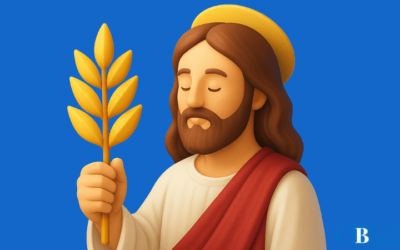Approximately between 1,200 and 1,500 years from Moses to John on Patmos.
Why did a single book take more than a thousand years to write?
Can you imagine a work that took longer to complete than any other in the history of humanity?
A text written by more than 35 people, in different languages, from kings to peasants, over more than a thousand years… and that still transforms lives today?
That's the Bible.
This sacred book was not written all at once, nor by a single author, nor with a human editorial plan.
It was forged over generations, amidst wars, exiles, prophetic visions and encounters with the divine.
But how did this process actually unfold?
Was it written in chronological order?
Who decided which books to include?
And what does this long process tell us about God's character and his way of revealing himself?
In this article, we explore each stage, from the original languages to the inspiration of the Holy Spirit, including canonization and the cultural impact that still resonates today.
Prepare to discover how time was not an obstacle, but a divine tool to write the most powerful story ever told.
Introduction to the time of writing of the Bible
Understanding the time it took to write the Bible not only responds to historical curiosity, but also allows us to appreciate its spiritual depth, its consistency throughout the centuries, and its lasting impact on humanity.
Here I explain why this topic is so relevant for both believers and scholars:
1. Importance of understanding the biblical writing process
The process of writing the Bible was extensive, complex, and carefully guided.
It is not a book written by a single author, but rather a collection of sacred texts developed over centuries.
a. A text that spans generations
The Bible was written by multiple authors at different times.
Each author wrote from his or her own cultural, political, and spiritual context, which enriches the message without fragmenting it.
b. Divine inspiration and human participation
Christian doctrine holds that God inspired authors to write his Word.
This means that although it was written by humans, its origin is supernatural.
c. An orderly, not improvised, revelation
The order in which the texts were written was not random.
Each book responds to a specific need of its time, and together they construct a coherent narrative from creation to eternity.
2. Overview of the total duration and its spiritual and cultural impact
The Bible is estimated to have taken between 1,200 and 1,500 years to complete.
During that period, its content gradually influenced entire civilizations.
a. An unprecedented spiritual legacy
The Bible has transformed lives, nations, legal systems, and ethical values.
His message has been the basis for social movements, religious reforms, and profound personal decisions.
b. Universal cultural impact
In addition to the spiritual, the Bible has left its mark on art, literature, music, education, and politics.
Masterpieces such as “The Last Supper,” “Paradise Lost,” and even human rights are rooted in biblical values.
c. The Bible as a bridge between generations
There is no other book that has spanned so many generations, been translated into so many languages, and adapted to so many cultures without losing its essence.
The fact that it has been written for centuries contributes to that timeless universality.
What does it mean that the Bible was written over time?
To understand the richness of the Bible, it is essential to understand that its content did not emerge all at once, nor through the work of a single author.
The Bible is the result of a progressive process of revelation and writing that extended over more than a thousand years.
Here I explain in detail what this statement implies:
1. The concept of progressive revelation
Progressive revelation is a key idea for understanding how God communicated His will to humanity over time.
He did not deliver his entire message at once, but rather revealed it gradually, according to the historical moment and the spiritual maturity of the people.
a. God reveals his plan in stages
From Genesis to Revelation, we see God revealing more aspects of his character, his promises, and his plan of redemption.
What appears in the early books as promises or symbols is developed more clearly in the prophets and is fully fulfilled in Jesus Christ.
b. Each stage has a specific purpose
The revelation is not repetitive or unnecessary.
Each new book brings something different and necessary to complete the understanding of God's message.
c. Revelation finds its fullness in Christ
The New Testament presents Jesus as the culmination of everything revealed before.
Hebrews 1:1-2 says, “God, who spoke in time past at various times and in various ways…has spoken to us by his Son.”
This confirms that the process had a clear and perfect end.
2. How the Bible was not written all at once
Contrary to what many people imagine, the Bible was not written as a single manuscript, nor in a single historical period.
Its formation was a complex process, distributed among different authors, places and circumstances.
a. Writing distributed in different periods and contexts
Some books were written in times of peace and prosperity, such as the Psalms of David.
Others were born in the midst of exile, persecution, or the expansion of the church, such as Lamentations or the letters of Paul.
b. Diversity of literary styles and genres
The Bible includes history, poetry, laws, prophecy, gospels, and letters.
Each one was written at a specific time, reflecting the culture, language, and needs of its time.
c. Continuous testimony of God's actions
Although it was written at different times, the Bible maintains a common thread:
the testimony of God's actions in history, his relationship with human beings and the promise of redemption.
Accepting that the Bible was written over time helps us appreciate its depth, its thematic unity, and the wisdom with which it was formed.
How many years did it take to write the entire Bible?
The Bible was not written in one generation or even in one century.
Its composition spans more than a thousand years of human and spiritual history, making it a unique work in both length and depth.
Here I explain in detail the approximate time it took to write and the key periods that marked its evolution:
1. Total chronological estimate: more than 1,500 years
According to the most widely accepted studies by historians and theologians, the Bible was written over a period of approximately 1,200 to 1,500 years.
This period covers from the time of Moses to the apostle John in the 1st century AD.
a. The Pentateuch as a starting point
Most experts agree that Moses began writing the Pentateuch (Genesis, Exodus, Leviticus, Numbers, and Deuteronomy) around the 15th century BC.
This set of books marks the beginning of written revelation.
b. The Apocalypse as a final closure
The last book to be written was the Apocalypse, written by the apostle John between 90 and 100 AD.
This marks the end of the biblical canon and the conclusion of written revelation.
c. A long-winded work
It is not about 1,500 years of uninterrupted writing.
Between books, there were periods of silence, wars, restorations, and changes of empire that influenced the production of the texts.
2. Key historical periods that mark the evolution of texts
The development of the Bible reflects the great historical and spiritual movements of God's people.
Each stage contributed a set of essential books to the canon.
a. Period of the Exodus and the conquest of Canaan
The first books were written here under the direction of Moses and then Joshua.
They focus on the law, the identity of the people, and divine promises.
b. Age of kings and prophets
During the reign of David, Solomon and their successors, Psalms, Proverbs, Song of Songs and other wisdom texts were written.
The major and minor prophets also emerge at this time, denouncing idolatry and announcing hope.
c. Exile in Babylon and return
Books like Lamentations, Ezekiel, and Daniel were born amidst the pain of exile.
The return to Jerusalem leads to the reorganization of the cult and the compilation of ancient writings.
d. Intertestamental period
Although no canonical books were written, it was a key period for the consolidation of the law, synagogues, and oral traditions.
This sets the stage for the arrival of Jesus.
e. Apostolic Era and Writing of the New Testament
The Gospels, Acts, the apostolic letters and the Apocalypse were written between 50 and 100 AD.
They respond to the needs of the early churches and the expansion of Christianity.
The Bible is, therefore, a carefully constructed, ancient work that spans the great moments of salvation history.
Who wrote the Bible?
One of the most amazing features of the Bible is the diversity of its authors.
It was not written by sages locked in ivory towers, but by ordinary people and chosen leaders who lived in different contexts.
Here I explain who they were and how this relates to their divine inspiration:
1. Prophets, kings, fishermen, doctors: inspired authors
The biblical writers came from diverse social, economic, and cultural backgrounds.
This makes the biblical message accessible, human, and relevant to everyone.
a. Diversity of professions and contexts
- Moses He was an Egyptian prince, shepherd and leader of the Hebrew people.
- David He was a shepherd and king, author of many psalms.
- Isaiah and Jeremiah They were prophets called in difficult times.
- Amos He was a shepherd and a fig picker.
- Matthew He was a tax collector.
- Peter He was a fisherman.
- Pablo He was a Pharisee and then an apostle to the Gentiles.
- Luke He was a doctor and historian.
This variety reflects how God can use any willing person to communicate His truth.
b. Writers in different realities
Some wrote in palaces, others from prisons, deserts or in exile.
His writings are marked by personal experience, but guided by the same Spirit.
2. God as divine author and the role of human writers
Although each book reflects the style of the human author, the entire Bible claims a single source of inspiration: God himself.
a. Verbal and dynamic inspiration
According to 2 Timothy 3:16, “All Scripture is inspired by God…”
This means that God guided the authors without nullifying their personality, context, or style.
b. A coherent message despite diversity
It is surprising that a work written over a period of more than 1,000 years by more than 35 authors maintains the same vision, the same prophetic voice, and the same hope.
This internal coherence is only possible if there is a divine mind behind everything.
Acknowledging human writers does not diminish the authority of the Bible.
On the contrary, it confirms it as a work where the eternal unites with the earthly to give us a living and transformative truth.
Chronology of the Old Testament
The Old Testament was written over a period of more than a thousand years, reflecting the history, laws, promises, and challenges of the people of Israel.
To understand his development, it is essential to know the approximate dates when his books were written and the context in which they emerged.
Here I explain in a clear and orderly manner how their texts are structured chronologically:
1. From Moses to Malachi
The writing of the Old Testament begins with Moses, traditionally considered the author of the Pentateuch, and ends with the prophet Malachi, the last to speak before the so-called "period of silence."
a. Moses and the beginning of sacred writing
It is estimated that Moses wrote between 1445 and 1405 BC, during the exodus from Egypt and the pilgrimage in the desert.
His writings established the doctrinal, legal and spiritual foundation of the Hebrew people.
b. The later prophets and sages
As Israel becomes a kingdom and then a divided nation, prophets, sages, and scribes emerge.
Each of them provides messages, warnings and teachings relevant to their time.
c. Malachi as the last written prophet
The book of Malachi was written approximately between 450 and 430 BC, closing the Old Testament canon in chronological terms.
2. Approximate dates of writing of each book
The dates are estimated based on biblical, archaeological and historical studies.
Here's a timeline with some representative examples:
to. Pentateuch – writings of Moses
- Genesis – Deuteronomy: c. 1445–1405 BC
b. Historical books
- Joshua: c. 1400 BC
- Judges: c. 1050 BC
- 1 and 2 Samuel: c. 930 BC
- 1 and 2 Kings: c. 560 BC
- Ezra and Nehemiah: c. 450–430 BC
c. Poetic and wisdom books
- Job: c. 2000–1000 BC (very ancient origin)
- Psalms: c. 1000–400 BC
- Proverbs, Ecclesiastes and Song of Songs: c. 950 BC
d. Major and minor prophets
- Isaiah: c. 700 BC
- Jeremiah and Lamentations: c. 626–580 BC
- Ezekiel: c. 593–571 BC
- Daniel: c. 530 BC
- Hosea – Malachi (minor prophets): c. 840–430 BC
The chronology of the Old Testament not only organizes sacred history, but also shows the continuity of the divine message through the centuries.
Now we move on to the period where that promise is fulfilled: the New Testament.
Chronology of the New Testament
The New Testament was written in a much shorter period than the Old Testament, but with unparalleled intensity and historical significance.
From the accounts of Jesus' life to the letters of the apostles, each book reflects an evangelizing urgency and a direct response to the context of its time.
Here's how this key section of the Bible developed:
1. From the Gospels to the Apocalypse
The writing of the New Testament began a few years after the death and resurrection of Jesus, and was completed by the end of the 1st century.
a. Gospels: living memory of Jesus
The Gospels were written between 50 and 70 AD.
Matthew, Mark, Luke, and John compile the deeds, teachings, and miracles of Jesus to preserve and transmit them to the new Christian communities.
b. Apostolic Letters: Guide for the Churches
The letters of Paul, Peter, John, James, and Jude were written between 50 and 90 AD.
Its purpose was to instruct, correct, and encourage the early churches that faced persecution, divisions, and false doctrines.
c. Apocalypse: vision of the end and future hope
Written by the apostle John on the island of Patmos around 95 AD, the Apocalypse is the prophetic closing of the New Testament.
It presents visions of the end times and the final victory of Christ.
2. The urgency of recording the life of Jesus
The early Christians believed in the imminent second coming of Christ.
However, as eyewitnesses began to die, the need arose to faithfully record the deeds of Jesus.
a. Preserve the apostolic testimony
The Gospels were written to accurately preserve the teachings of Jesus.
This avoided distortions and strengthened the faith of the new generations.
b. Dissemination of the message to new cultures
With the expansion of Christianity to the Gentile world, it was vital that the message be clear and accessible.
That is why the Gospels are written in Koine Greek, the common language of the Roman Empire.
3. Political context of the Roman Empire
The environment in which the New Testament was written was marked by Roman domination, religious syncretism, and increasing persecution of Christians.
a. Initial freedom and subsequent hostility
At first, Christianity was seen as a tolerated Jewish sect.
But over time, he became a target of persecution for refusing to worship the emperor.
b. Infrastructure that favored expansion
Roman roads, linguistic unity, and the postal system allowed for the rapid dissemination of Christian writings.
This was key to the letters and gospels reaching multiple churches.
c. The cross as a symbol of redemption under an oppressive empire
What for Rome was an instrument of torture, for Christians became the emblem of God's redemptive love.
This revolutionary message prompted the urgent and fervent writing of the New Testament.
Thanks to this historical and spiritual context, the New Testament was written with clarity, power, and purpose.
Why did it take so long to write the Bible?
The long process of writing the Bible was not a mistake or a deficiency.
On the contrary, it responds to historical, cultural, spiritual, and logistical factors that allowed its message to mature and consolidate faithfully.
Here I explain why the writing of the Scriptures took so long:
1. Oral transmission in the first generations
Before the custom of writing everything down existed, teachings and stories were passed down orally from generation to generation.
This method was common and highly respected in ancient cultures.
a. The stories were memorized in community
Semitic peoples, like Israel, had a rich oral tradition.
The stories of Genesis, Exodus, and the patriarchs were told repeatedly at family gatherings and celebrations.
b. Preservation without immediate writing
Fidelity in oral transmission was key.
It was not necessary to write immediately, because the entire community was responsible for preserving history accurately.
c. Writing comes when there is a need
Only when the need arose to consolidate national identity or respond to crises, such as exile or dispersion, was writing more frequently used.
2. Differences in access to materials and literacy
Unlike today, in ancient times writing was a privilege reserved for a few.
Not everyone knew how to read or write, and materials were expensive and difficult to obtain.
a. Shortage of scrolls, ink and tools
Papyrus and scrolls were expensive.
Scribes had to carefully prepare the materials and write by hand, which made the process slow and laborious.
b. Limited literacy
The majority of the population could neither read nor write.
Therefore, religious leaders and scribes were relied upon to record and read the sacred texts to the people.
c. Manual production without printing
Until the invention of the printing press in the 15th century, all copies had to be made manually.
This involved long hours, extreme precision, and the risk of wear and tear or errors.
3. Persecutions and difficulty of conservation
Throughout biblical history, both Jews and Christians faced persecution that made it difficult to write and preserve texts.
a. Losses due to wars and exiles
During invasions such as those of Babylon or Rome, many texts were lost or destroyed.
This required rewriting or re-compiling some of the content.
b. Hide and protect the manuscripts
In times of persecution, manuscripts were hidden in caves, as was the case with the Dead Sea Scrolls.
They were also shared in secret, especially in the early centuries of Christianity.
c. Risk of distortion and fragmentation
The lack of security in times of crisis put the texts at risk of being altered.
For this reason, the early church took rigorous care to ensure the faithful preservation of each manuscript.
The Bible was not written quickly because it was not improvised.
Every stage, every pause, and every manuscript was part of a greater plan, revealed with divine wisdom and eternal patience.
The role of ancient cultures in biblical writing
The Bible was not written in a cultural vacuum.
On the contrary, it developed within contexts influenced by great empires such as Egypt, Babylon, Greece and Rome.
Here's how these civilizations impacted both the style and content of Scripture:
1. Influence of Egypt, Babylon, Greece and Rome
Each of these civilizations left a particular mark on the biblical world.
From forms of government to writing methods, the cultural environment profoundly affected the development of sacred text.
a. Egypt: the scene of the birth of Israel
Egypt represents the context in which Moses was raised and educated.
There he learned to read, write, and organize laws, which influenced the writing of the Pentateuch.
b. Babylon: cradle of exile and prophetic hope
During the Babylonian exile, the Jews faced an identity crisis.
It was in this context that books such as Daniel, Ezekiel, and Lamentations emerged, marked by visions, dreams, and hope for restoration.
c. Greece: the language of the New Testament
Greek rule left as a legacy Koine Greek, the lingua franca in the time of Jesus.
This language allowed the Gospels and apostolic letters to be understood in much of the ancient world.
d. Rome: structure, roads and persecution
The Roman Empire provided infrastructure, laws, and efficient communication, which aided the spread of the Christian message.
But it was also the oppressive system that persecuted believers and crucified Jesus.
2. How did these civilizations affect style and content?
Beyond history, these influences shaped how the Bible was written and how its message was communicated.
a. Literary styles adapted to the environment
- The use of parables in the Gospels reflects common forms of Jewish and Hellenistic teaching.
- The Psalms combine Hebrew poetry with musical structures typical of Semitic culture.
b. Contextual themes with an eternal background
Many books address themes such as oppression, freedom, justice, and hope, reflecting the experiences lived under these empires.
But they always do so from a spiritual perspective that transcends human cultures.
c. God above all empires
A constant lesson in the Bible is that although these civilizations were powerful, none surpassed God's plan.
His Word prevailed over kings, pharaohs and emperors.
Understanding the role of these cultures allows us to better understand the symbols, metaphors, and messages of the biblical text.
The Bible does not isolate itself from the world, but illuminates it from within.
Was the Bible written in chronological order?
Although many people assume that the Bible is organized in the order in which its books were written, this is not entirely true.
Here I explain in detail why:
Differences between the order of writing and canonical order
He writing order refers to the chronology in which the texts were actually written by their authors.
Instead, the canonical order corresponds to how they were finally organized within the biblical canon recognized by religious tradition.
In many cases, the books were grouped thematically rather than chronologically.
For example, in the Old Testament the historical books do not always follow the actual order of the events narrated.
Likewise, the New Testament epistles are arranged by length and author, not by date of writing.
This creates a structure that responds more to liturgical and editorial criteria than to a historical timeline.
Examples of books written after but placed before
One of the most notable cases is the book of Job.
Although it appears among the poetic books of the Old Testament, many scholars believe that its writing is very ancient, even predating the texts of Moses.
Another example is the Gospel of John.
Although it is found with the other gospels at the beginning of the New Testament, it was the last to be written, possibly around 90 AD.
Paul's letters were also written before the Gospels, although they appear later in the Bible.
The first letter to the Thessalonians, for example, was written around 50 AD, before the Gospel accounts were committed to writing.
This shows that the order in which we read the Bible does not always reflect the historical development of its composition.
Languages and materials used in writing
The Bible was written in several languages and on different materials that evolved over time.
Here I explain which were the most important in its transmission:
Hebrew, Aramaic, and Koine Greek
He Hebrew It was the main language of the Old Testament.
It was the mother tongue of the people of Israel, and was used especially in historical, poetic and prophetic books.
He Aramaic, a Semitic language related to Hebrew, was used in some later sections of the Old Testament.
For example, parts of the books of Daniel and Ezra are written in Aramaic.
This language was widely spoken in the Near East during and after the exile.
He Koine Greek It was the common language of the Roman Empire and was used to write the New Testament.
It was also the language of the Septuagint, the first translation of the Old Testament, made in Alexandria.
Thanks to this diversity of languages, the Bible could be spread to different peoples at different times.
From scrolls to codices: how the media evolved
In the beginning, the biblical texts were written in scrolls, which were rolls made of animal skin.
These scrolls were long and were read by unrolling them with both hands.
Over time, these rolls were replaced by codices, which are the ancestors of the modern book.
The codex allowed for quick consultation of different passages and facilitated public reading in Christian communities.
The change from scroll to codex was crucial for the spread of Christianity.
It allowed the Scriptures to be copied more easily and distributed more widely.
Furthermore, in both Hebrew and Greek, the manuscripts were handwritten with great dedication by the scribes, demonstrating respect for the faithful transmission of the divine message.
Canonization process: When was it recognized as a Bible?
The formation of the biblical canon was a long and complex process that did not occur instantaneously.
Here I explain how the books we now consider part of the Bible were officially recognized:
Old Testament: gradual acceptance among Jews
The canon of the Old Testament was gradually formed over several centuries.
The first accepted writings were the Torah or Pentateuch, attributed to Moses, and were considered sacred since very ancient times.
Later, historical, wisdom and prophetic books were added.
However, not all Jews shared exactly the same list of books.
In the 1st century AD, after the destruction of the Temple of Jerusalem, many scholars point out that the Council of Jamnia (around 90 AD) was key to consolidating the Hebrew canon, although it was not a formal council in the Christian sense.
The Jews of Palestine tended to accept a smaller canon, while the Jews of the Diaspora, especially in Alexandria, also used additional Greek texts that would become part of the Septuagint.
New Testament: councils, debates and criteria
The New Testament canon was not defined immediately after Jesus' life.
During the first centuries, many writings circulated among Christian communities: gospels, letters, apocalypses, and pastoral texts.
The criteria used to determine which books were inspired included:
- Apostolic authorship or direct proximity to the apostles
- Widespread acceptance in the churches
- Doctrinal conformity with the teaching of Christ and the apostles
The first partial lists of New Testament books appear in the 2nd century, such as the Muratorian Fragment.
Finally, in the councils of Hippo (393 AD) and Carthage (397 AD), a list of 27 books that coincides with the current New Testament was ratified.
This decision was confirmed by Pope Damasus I and later reaffirmed at the Council of Trent in the 16th century, in response to the Protestant Reformation.
Deuterocanonical books and their inclusion in some versions
In addition to the widely accepted canon, there are books known as deuterocanonical books that have generated debate about their place in the Bible.
Here I explain their origin and why they don't appear in all versions:
When were they written?
The deuterocanonical books were written between the 3rd and 1st centuries BC, in the intertestamental period, when there were no longer active prophets in Israel.
They were written mostly in Greek, although some are based on Hebrew texts that are now lost.
Among them are: Tobit, Judith, Wisdom, Ecclesiasticus, Baruch, 1 and 2 Maccabees, and some additions to Esther and Daniel.
They were included in the Septuagint, the Greek translation of the Old Testament used by Jews in the Diaspora and widely cited by early Christians.
Why aren't they in all Bibles?
During the Protestant Reformation in the 16th century, Martin Luther and other reformers chose adopt only the books of the Hebrew canon as the Old Testament.
For this reason, the deuterocanonical books were excluded from many Protestant editions of the Bible, and they began to be called “apocrypha.”
The Catholic Church, on the other hand, reaffirmed its inclusion as part of the official canon in the Council of Trent (1546), considering that they had been used continuously by the Church since its origins.
Catholic Bibles include these books, while Protestant editions may omit them or include them in a separate section.
They are also found in Eastern Orthodox Bibles, often with an even more extensive list of additional texts.
The importance of the Holy Spirit in the whole process
Throughout the centuries, the Holy Spirit has been regarded by believers as the divine agent behind the composition, preservation, and transmission of the Bible.
Here I explain how his intervention is perceived from beginning to end:
Divine inspiration from the first to the last verse
Christians believe that the Bible is not simply a collection of human writings, but was inspired by God through the Holy Spirit.
This inspiration does not mean word-for-word dictation, but rather that the authors wrote guided by a divine influence that guaranteed the truth of the message.
Texts like 2 Timothy 3:16 affirm that “all Scripture is inspired by God.”
This ranges from Genesis to Revelation, showing a supernatural intent throughout.
Even in the most difficult times of writing, such as during the Babylonian exile or the persecutions of the Roman Empire, the Holy Spirit is believed to have sustained the authors.
This belief strengthens the spiritual authority of the Bible in the Christian faith.
Thematic unity despite the centuries
One of the most cited evidences of the action of the Holy Spirit in the Bible is his thematic unit despite having been written over a period of more than 1,000 years, by more than 40 different authors.
From the creation story to the promise of a new creation, the Bible maintains a consistent thread: God's plan of redemption for humanity.
The books dialogue with each other, anticipating, fulfilling, and clarifying events and promises.
Prophecies of the Old Testament are fulfilled centuries later in the New Testament, showing a harmony that goes beyond human logic.
This unity is seen as a work of the Holy Spirit who inspired the writers to maintain a coherent and lively narrative.
Comparison with other religious books
The Bible has been compared over time with other sacred texts of the world.
Here we analyze how long some of these texts took to write and what makes the Bible unique in this regard:
How long ago were the Quran, Bhagavad Gita, etc. written?
He Koran It was written in a relatively short period, approximately between the years 610 and 632 AD, during the lifetime of the prophet Muhammad.
It is considered a direct revelation that he received and was memorized and then written down by his followers.
He Bhagavad Gita, part of the epic poem Mahabharata of the Hindu tradition, was composed between the 5th and 2nd centuries BC
Although it is based on an older oral tradition, its final version covers a limited period compared to the Bible.
He Tipitaka, a sacred text of Buddhism, was written about 400 years after Buddha's death, compiling oral teachings.
Its composition was also accomplished within a relatively compact time frame.
These texts, although important in their respective religions, present a much shorter chronology than the Bible.
What makes the Bible unique in this regard?
The Bible was written over a period spanning more than a thousand years, by different authors, in different cultural, historical and linguistic contexts.
This temporal breadth is unique among religious books.
Furthermore, the authors belonged to different professions: kings, peasants, prophets, fishermen, doctors, tax collectors, and more.
Still, the message of the Bible presents a amazing doctrinal and spiritual coherence.
This characteristic, coupled with its global influence and translation into more than 3,000 languages, makes the Bible stand out not only for its longevity but also for its continuing impact.
For believers, this uniqueness is evidence of their divine origin and the constant work of the Holy Spirit throughout the centuries.
The impact of a work written for centuries
The Bible, having been written over more than a thousand years, represents not only a collection of religious texts, but also a work with a profound impact on the history, culture, and morality of various civilizations.
The main effects of its continuity over time are explained here:
Prophetic continuity
From the Old Testament to the New Testament, a prophetic sequence is observed that maintains a coherent theological line.
Old Testament prophecies anticipate events that unfold centuries later, reinforcing the perception of a unified divine design.
Examples such as the birth in Bethlehem, the passion of the Messiah, or the restoration of Israel are frequently cited as evidence of this continuity.
This succession of announcements and fulfillments contributes to the credibility of the biblical message for believers.
Historical achievements
Various biblical accounts have been confirmed, in part or in full, by archaeological finds and historical research.
Events such as the Babylonian exile, the destruction of Jerusalem, or the existence of figures like King David have been supported by sources outside the sacred texts.
Although not all events have empirical verification, the convergence between the Bible and history in multiple cases has generated academic recognition of the documentary value of the biblical text.
This connection with real historical events has strengthened the Bible's influence as a reliable source of knowledge about the past.
Cultural and moral transformation
The Bible has profoundly shaped legal, ethical, and social structures in multiple civilizations, especially in the West.
Concepts such as human dignity, justice, forgiveness and moral responsibility have been strongly influenced by its content.
Education, social welfare, and human rights in many nations have been developed on foundations inspired by biblical principles.
Furthermore, art, music, and literature have frequently drawn on biblical passages as a source of inspiration.
Its impact extends beyond the religious sphere, leaving its mark on systems of thought, models of government, and social relations.
Recommended books to delve deeper into this topic
For those who wish to study in greater depth how the Bible was written and why it has had such an impact throughout history, these books offer rigorous and accessible analyses:
📘 How the Bible Was Written – Bart D. Ehrman
A historical-critical analysis of the processes of composition, editing, and canonization of biblical texts.
Ehrman, an expert in New Testament studies, offers a scholarly look at the origins of the sacred text.
📗 The Story of the Bible – Karen Armstrong
A historical exploration of the evolution of the biblical text from its roots to the modern era.
Armstrong highlights how different traditions have interpreted and reframed the Bible according to their cultural contexts.
📙 Can We Trust the Bible? – John Stott
From a Christian perspective, this book addresses the doctrinal and rational foundations that support the reliability of Scripture.
Stott analyzes theological and historical arguments in defense of biblical inspiration and veracity.
This is only for entrepreneurs, business owners and freelancers with faith
Are you building something with eternal purpose and not just temporary gain?
God not only gave you talent, he also gave you vision.
Here are some tools to help you grow without losing your principles:
🚀 Launch your purpose-driven website or platform in NippyLaunch.com
Technological solutions designed for those who serve with integrity, without compromising their values.
From online stores to course platforms or memberships, do it with order and excellence.
📈 Create advertising campaigns based on truth in CleefCompany.com
Digital marketing that respects biblical principles.
Promote your business with honesty, strategic focus, and measurable results.
🧮 Optimize your decisions with CalculatorCCH.com
More than 600 calculators and tools designed for entrepreneurs seeking to make decisions with divine wisdom.
From finance to health, all in one place.
Final reflection: What do we learn from the time it took to write the Bible?
The Bible, written over more than a thousand years, leaves us with a powerful teaching about God's work throughout time.
Here I share with you three essential lessons to apply in our lives and entrepreneurship today:
Divine patience in revealing his will
God was in no hurry to reveal himself.
It inspired each author in his or her own time, in different generations and contexts.
This patience shows that His plan is perfect, although not always immediate.
As entrepreneurs, we must learn to trust long processes.
God continues to work in us, even if we don't see immediate results.
The value of slow and transformative processes
Each book of the Bible reflects different stages in the history of humanity and the people of God.
They were not written to hasten the transformation, but to accompany it.
Likewise, our projects, businesses, and callings require time to mature.
It's not just about growing fast, it's about building something that lasts.
How it inspires us today to live with eternal vision
The Bible teaches us that living with eternal vision gives meaning to our daily decisions.
Every effort we make with fidelity can be part of a larger plan.
Entrepreneurship with purpose means building not only for the present, but also for eternity.
Just as God was faithful in writing His story, we can be faithful in writing ours.
Frequently Asked Questions About the Time of Writing of the Bible
How long did it take to write the Bible?
Approximately 1,200 to 1,500 years from Moses to John on Patmos.
Who wrote the first book of the Bible?
Traditionally, Moses is credited with being the author of Genesis.
What was the last book written?
The Apocalypse, written by the apostle John around 95 AD
Did Jesus write any books of the Bible?
No. Jesus did not leave any writings of his own, but his teachings are in the Gospels.
How many authors did the Bible have?
It is estimated that between 35 and 40 different authors, inspired by God.
How were the texts preserved for so many centuries?
Through hand copies, scrolls, oral traditions and believing communities.
Is the current order of the books chronological?
Not necessarily. Some books were written earlier but appear later.
What original languages were used in the Bible?
Mainly Hebrew, Aramaic and Koine Greek.
Were the books written one after the other without interruptions?
No. There were centuries of difference between some books, with periods of silence.
Why is this long process important for the Christian faith?
It reflects how God works in time, forming a coherent history of redemption.
Conclusion
The Bible is not just an ancient book; it is the living testimony of a God who works with purpose, patience, and perfection over time.
Every page written over the centuries reminds us that divine plans are not rushed, but are always fulfilled.
Its unified message, passed down through generations and cultures, invites us to trust that our own stories are also part of something much bigger.
Whether you're starting a new project, facing a wait, or searching for answers, the Bible inspires us to walk with faith and eternal vision.
Because if God took more than a thousand years to reveal his Word... how much more will he care about the details of your life?
What part of the Bible writing process impacted you the most?
I'll read you in the comments: share your reflection or your personal experience with the Word of God.
Discover How the Bible Can Transform Your Life
- Bible Study – explore the teachings of the Bible and find answers to life’s challenges.
- Fundamental Beliefs – delves into the principles that have guided millions through the centuries.
- Spiritual Growth – Strengthen your faith with studies designed to bring you closer to God.

Discover How the Bible Can Transform Your Life
- Bible Study – explore the teachings of the Bible and find answers to life’s challenges.
- Fundamental Beliefs – delves into the principles that have guided millions through the centuries.
- Spiritual Growth – Strengthen your faith with studies designed to bring you closer to God.



























0 Comments